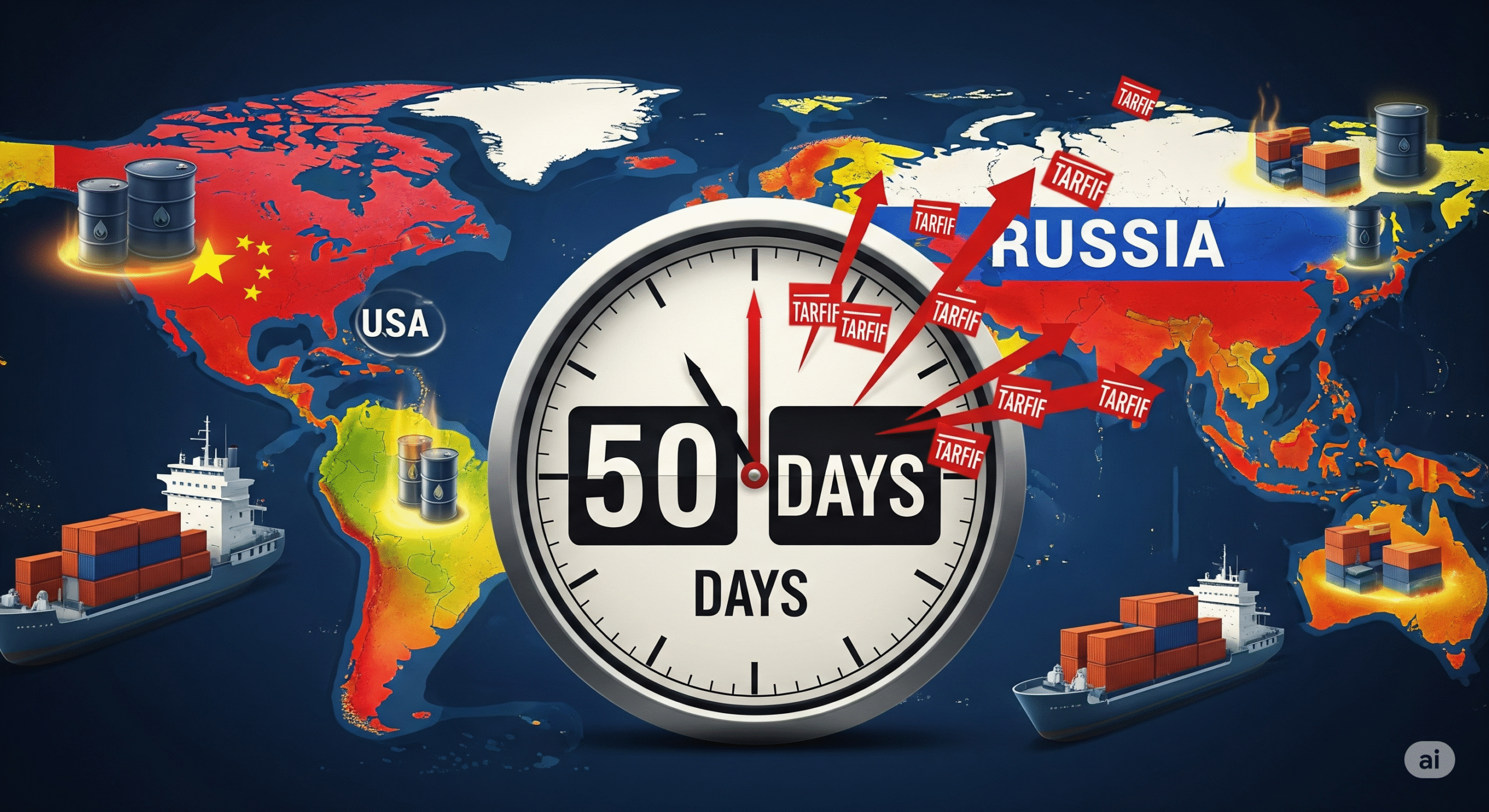Date: July 15, 2025
By: Team MyFinanceFuel
Former President Donald Trump just sent shockwaves across the globe — again.
At a press briefing late Monday, Trump issued a 50-day ultimatum to Russia to end the war in Ukraine or face a 100% tariff wall from the United States. Even more striking: he threatened “secondary tariffs” on China, India, Brazil, and any country that continues trading with Russia.
“If Russia doesn’t stop the war in 50 days, they’ll face tariffs that make them regret every Ruble spent on the invasion,” Trump said. “And if other countries keep trading with them, they’ll be next.”
Let’s break down what this means — for global politics, the economy, and most importantly, your wallet.
💰 How Could These Tariffs Impact U.S. Consumers?
If enacted, these 100% tariffs would double the price of goods imported from Russia, and potentially increase costs of products from countries like China and India that trade with Russia.
That means:
-
🔺 Higher prices for electronics, autos, and industrial goods
-
🔺 Supply chain delays — especially in tech and energy
-
🔺 Inflation risk: tariffs could fuel another consumer price surge, which the Fed is already battling
🧠 Why It Matters: In 2018, Trump’s steel and aluminum tariffs triggered a spike in U.S. manufacturing costs. A similar or worse effect could happen now — across more industries.
🌍 What Are “Secondary Tariffs” — and Why They Matter?
Secondary tariffs are sanctions imposed not just on the target country (Russia), but also on other nations doing business with that country.
Trump directly named China, India, and Brazil as potential targets if they “enable Russia economically.”
This could:
-
Erode U.S. trade ties with key partners
-
Spark retaliatory tariffs on American exports
-
Slow down global trade — just as supply chains were stabilizing
💥 Example: If China continues buying Russian oil, the U.S. might hit Chinese exports to America with additional taxes — and China might respond with its own.
🛰️ NATO & Weapon Sales: Europe Pays, U.S. Supplies

Trump also announced a new NATO-backed arms deal, where the U.S. will supply weapons to Ukraine, but Europe foots the bill.
This flips the narrative from the U.S. “paying for everyone else’s defense” to profiting from foreign military sales.
-
💵 Boost for U.S. defense contractors
-
📦 Increase in domestic weapons manufacturing
-
🤝 Strategic shift in how NATO finances war support
📈 This could push stocks like Lockheed Martin (LMT), Raytheon (RTX), and General Dynamics (GD) higher — investors will be watching closely.
🗳️ Political & Public Reaction in the U.S.
This move is already controversial:
-
Supporters argue it’s a strong, clear policy that could force an end to the war and boost U.S. manufacturing.
-
Critics say it risks global recession, raises prices at home, and damages U.S. diplomatic relations.
Congressional Democrats and some GOP leaders are expected to push back, citing inflation, global market volatility, and the threat of trade wars.
📊 What Financial Experts Are Saying
Janet Keller, Senior Economist at U.S. MacroWatch:
“If implemented, these tariffs could have a domino effect. We’d likely see price jumps in commodities and supply chain disruptions — not unlike what we saw during the COVID years.”
Paul Grayson, former trade advisor:
“Secondary tariffs are a nuclear option. They punish allies and adversaries alike. The fallout could be massive — but it’s designed to force countries to choose a side.”
🔍 Fast Facts
-
🗓️ Deadline: ~Sept 3, 2025
-
🌐 Impacted countries: China, India, Brazil
-
💬 Trump says: “Time’s up for war — or you’ll pay.”
-
📉 Possible fallout: Inflation, trade wars, stock market volatility
💬 Why It’s a Big Deal
This policy shift could:
-
🧨 Strain U.S. trade ties with China, India
-
💰 Affect global supply chains, oil, and tech
-
🏦 Rattle markets & interest rates
-
🔄 Create debate in Congress over executive power and economic impact
📊 What Experts Are Saying
“Secondary tariffs are like financial nukes. They punish everyone.” — Paul Grayson, former U.S. trade advisor
“We may see gas and consumer prices jump. Investors are watching closely.” — Janet Keller, MacroWatch
🧠 FAQ: Trump’s Tariff Ultimatum & U.S. Economy
🔹 When would the tariffs take effect?
Trump said 50 days from his announcement — putting the deadline around September 3, 2025.
🔹 Who will be most affected in the U.S.?
Industries like electronics, energy, automobiles, and retail may see cost increases.
🔹 Will this make gas prices go up?
Possibly. If oil-producing nations like Russia or Iran are affected, prices at the pump could rise.
🔹 How will markets respond?
Expect volatility in energy, defense, and tech sectors as companies react to trade uncertainty.
🔹 Can Biden stop this?
If Trump is acting under executive powers or as a returning political frontrunner, legal experts are debating the scope. Expect court challenges or counter-measures if Biden intervenes.